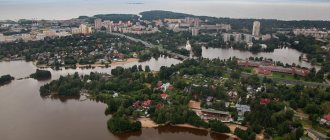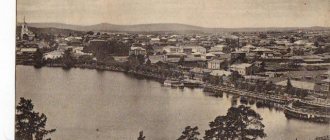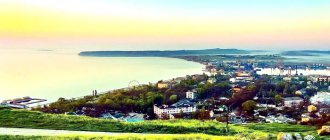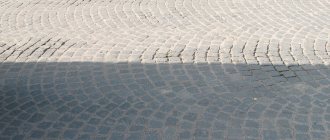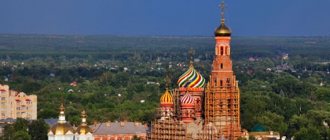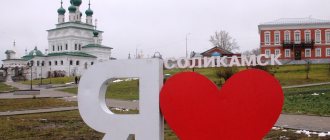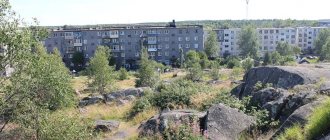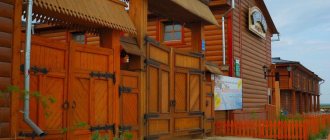A few facts about Medvezhyegorsk
- Medvezhyegorsk is located on the coast of Lake Onega, 152 km from the capital of the republic, Petrozavodsk. Once upon a time, the area in which this town is located was covered with impenetrable forests inhabited by wild animals.
- The population of Medvezhyegorsk is approximately 14.3 thousand people.
- The settlement has existed since 1916, but it received city status in 1938.
- In 1931, construction of the White Sea-Baltic Canal began here. The administration of the grandiose construction project was located in the village of Medvezhya Gora.
- From 1941 to 1944 the city was occupied by Finnish troops.
- In 1946, a disabled forced labor camp of the USSR Ministry of Internal Affairs was created in Medvezhyegorsk, subordinate to the Gulag.
- Vladimir Menshov’s cult comedy “Love and Doves” was filmed here, in Medvezhyegorsk. The house in which Vasily Kuzyakin lived with his wife Nadya and children Lenka, Lyudka and Olya was located on Nizhnaya Street, house 12.
- Twin cities of Medvezhyegorsk are the Finnish city of Sotkamo and the Russian city of Mozhaisk.
- There are a lot of bear sculptures in Medvezhyegorsk. Perhaps it ranks first in Russia in terms of the number of sculptures of this wild animal.
- There are restaurants and cafes in the city where you can try local Karelian cuisine, such as Lohikeito soup.
- The distance from Medvezhyegorsk to the Karelian city of Kondopoga is 110 km.
History, architecture and monuments of Medvezhyegorsk
Medvezhyegorsk grew up around the Medvezhya Gora railway station. Residents of the Republic of Karelia still call the settlement “Medgora” for short. Significant and tragic events of Soviet history are associated with these places. Many of them are reflected in historical places.
Railway station building
- Address: st. Artemyeva, 26A.
The Medvezhya Gora station, which gave rise to the future Karelian city, was built in 1916 on the section of the Murmansk railway between Petrozavodsk and Murmansk. The settlement became a city in 1935.
The railway station building has survived to this day and is one of the main historical and cultural attractions of modern Medvezhyegorsk. It is interesting from an architectural point of view. The object was created through the efforts of the famous architect and engineer Rufim Gabe; its appearance reflected various elements of traditional North Russian wooden architecture.
The house has a hip roof and a small spire resembling a “church dome”. Looking at the building, you can’t immediately say that this is a railway station - thanks to the decor and the combination of different elements, it rather resembles a carved mansion or a wealthy hut.
Petrovsky blast furnaces
- Address: s. Povenets, Medvezhyegorsky district.
In Peter's times, during the Northern War, the territories along the shores of Lake Onega were the sites for the production of cannons. The Petrovsky Mining Plants were founded here. One of these factories gave rise to the current capital - Petrozavodsk. The plant also operated in the area of modern Medvezhyegorsk.
Not far from the city, near the settlement of Povenets, on the banks of the Povenchanka River, blast furnaces from the early 18th century have been preserved - these are the remains of an enterprise that existed here until 1736. The attraction is the only one of its kind in Karelia.
Medvezhyegorsk fortified area
- Coordinates: 62.901365, 34.433313.
The line of fortifications was created by Finnish troops during the Great Patriotic War, after the occupation of Medvezhyegorsk. These defensive lines became the focus of the Finnish defense, the object was created on the orders of Mannerheim himself and, after the name of the city, was called in Finnish Karhumäki Castle (Finnish Karhu - bear, maki - mountain), and in Russian - Medvezhyegorsky fortified area.
The Finnish commander-in-chief himself visited these lands in 1942 to supervise the construction.
More than 40 objects have survived to this day. Today, the fortifications are partially destroyed and remind the Russian people of the death of many Soviet soldiers who stormed these powerful structures during the liberation of the Karelian town in 1944. The landmark, tragic in its history, traditionally arouses interest. The military-historical festival “Karelian Frontiers” and historical reconstructions of military events are held here.
Abandoned village of Pegrema
- Coordinates: 62.325661, 34.769598.
Pegrema is now an uninhabited village in the Medvezhyegorsky district. It was abolished when all the inhabitants left the area more than three decades ago, but it remains an important memorial site and is included in the list of protected areas. Objects of residential and temple architecture have been preserved here - examples of wooden architecture of the Russians of Zaonezhie. Among them is the chapel of Varlaam Khutynsky, built in the 70s of the 18th century.
But the settlement gained much greater fame thanks to the work of archaeologist A.P. Zhuravlev, who managed to discover sites of ancient man here. Excavations have been carried out in the village several times.
It turned out that on its territory there was the oldest deposit of copper ore in Europe. An ancient pagan sanctuary was also found on the territory of Pegrema - a cult complex that includes more than 100 objects made of stone. This is a memory of the beliefs and customs of the ancient primitive population of Karelia.
Berth of Medvezhyegorsk electronic warfare in the village of Pindushi
- Address: pos. Pindushi.
Since the filming of the legendary film “Love and Doves,” the places that appeared on the screen have significantly changed their appearance. One of the significant scenes was filmed at the pier of the Medvezhyegorsk fleet repair and maintenance base, which is located on the shore of Lake Onega, in the nearest suburb of Medvezhyegorsk - the village of Pindushi. It was here that the hero of the film Vasya drank beer.
The fleet repair and operational base is an enterprise that has existed since 1934, since the creation of the Pindus shipyard. As the name suggests, it repairs ships.
Monument to S.M. Kirov
- Address: Dzerzhinsky street.
The most famous monumental monument of the city is a sculptural image of the Soviet politician S.M. Kirov. Exactly the same monument stands on one of the main squares of the Karelian capital. The author of the Petrozavodsk and Medvezhyegorsk monuments is the same - Matvey Genrikhovich Manizer.
Why did the master sculpt two absolutely identical monuments? It was like this: during the Great Patriotic War, the Finns, who occupied Petrozavodsk, dismantled the monument to Kirov, and it got lost.
After the war, the authorities decided to restore the sculpture and turned to the still living author, he made a copy, which to this day stands near the Musical Theater on Kirov Square in Petrozavodsk. When the original monument was found, they decided not to return it on site, but to put it in Medvezhyegorsk, where the location of the monument to Kirov is quite logical, because it was related to the construction of the LBC.
Monument to Soviet Soldiers-Liberators
- Address: Lenin street.
In June 1944, the city of Medvezhyegorsk was liberated from Finnish occupation. In memory of this event, a combat vehicle - a T-34 tank - was installed in the city on Kirov Square. It appeared here on the occasion of the twenty-fifth anniversary of a significant historical event, in 1969, and became one of the most famous monuments of the city. Officially called the monument to Soviet soldiers-liberators.
Medvezhyegorsk City Library named after. I.A. Fedosova
- Address: st. Karl Marx, 14.
Residents of the city are well aware of the Medvezhyegorsk City Library. The name of the Zaonezhsky storyteller I.A. Fedosova was awarded to her in 1981. Irina Andreevna Fedosova was known far beyond the borders of her native Zaonezhye and Olonets province. She met with L.N. Tolstoy, A.M. Gorky.
Gorky dedicated his story “The Screamer” to her. The library is a meeting place for interesting people in the city and the continuation of the rich literary traditions of the region. The “Vstrecha” club has been operating at the library for more than 20 years.
City name
Near the city there is a railway station Medvezhya Gora , which gave its name to this settlement. There is a legend that once upon a time, the owner of a local sawmill named Zakharyev brought a small bear cub from the forest, which soon became his wife’s favorite. But one day the already grown-up bear severely injured the hand of the Zakharyevs’ adopted son.
Reluctantly, I had to shoot my beloved pet. He was buried with great honors at the foot of the mountain, which has since been called Bear. The wooden house in which the Zakharyevs lived still stands in the city.
The main attractions of Medvezhyegorsk: what to see, where to go for tourists
The history of the development of Medvezhyegorsk began with construction at the beginning of the twentieth century. railway connecting St. Petersburg and the northern territories. Then the settlement at the Medvezhya Gora logging factory received the status of a city. An exhibition located in a train carriage at the railway station tells about this stage of the life of the settlement.
When visiting the city you become immersed in its history.
The next important milestone in the history of the city is the construction of the White Sea Canal. You can learn about the construction of this facility and the life of local residents during the Soviet-Finnish and Great Patriotic Wars by visiting the local history museum in the building of the former White Sea Canal Administration.
In the vicinity of the city there are unique historical and natural monuments:
- fortifications and strongholds of the Finnish army;
- Vodlozersky Park;
- Pegrema village with an 18th century chapel. and so on.
They are available for inspection.
Souvenirs
The Karelian Patterns store is located at: st. Gorky, house 35.
In Medvezhyegorsk there is a factory “Karelian Patterns”, where they produce products with Zaonezh embroidery. In the store of the same name you can buy towels, tablecloths, napkins, aprons, curtains and other items with embroidery, as well as traditional souvenirs from Karelia.
Products from the Karelian Patterns factory are also sold in Petrozavodsk. And in the Medvezhyegorsk Museum there is an exhibition “History and Modernity of Zaonezh Embroidery”, where samples from the factory are presented.
How to get there
From Petrozavodsk (150 km) you can get there by bus, train or Express minibus, which depart from the Petrozavodsk bus station (fare 400 RUB, journey two hours, non-stop).
In addition, you can get there directly from Moscow or St. Petersburg by taking the train to Murmansk and getting off at Medvezhya Gora station. The journey from Moscow takes 18.5 hours, from St. Petersburg - 10.5 hours. Prices on the page are indicated for May 2022.
Search for cheap flights to Medvezhyegorsk
Sights of Medvezhyegorsk
The main attractions of Medvezhyegorsk are the White Sea-Baltic Canal (BBK), a Finnish line of fortifications built here in 1942-1944. In the vicinity of Medvezhyegorsk there is the Sandarmokh memorial complex - the site of executions of prisoners during the years of the Great Terror (1937-1938).
Read an overview of the most interesting sights of Karelia.
White Sea-Baltic Canal
Locks of the White Sea Canal
Technically, the White Sea Canal is a system of structures connecting Lake Onega with the White Sea. It made it possible to significantly shorten the route between the White Sea and the Baltic. However, the historical and cultural significance of this landmark of Medvezhyegorsk is enormous, because it is also a monument to the victims of political repression and a place of terrible torment for hundreds of thousands of people.
The White Sea-Baltic Canal has a length of 227 km, of which 37 kilometers had to be dug, and 19 locks, 15 dams and 51 dams had to be built. The canal was built in record time - less than 2 years. More than 200 thousand Belbaltlag prisoners took part in the construction, who worked in inhumane conditions and completed the entire gigantic amount of work without construction equipment. This was the first Soviet construction project of this scale to use prison labor; even the administration and engineers were prisoners.
Many of them died from cold, exhaustion or were killed - the White Sea Canal has a reputation as a “construction on bones” and is a monument to the Soviet era. No one can say the exact number of deaths on the White Sea Canal; historians give approximate figures of 40-50 thousand people.
Now the canal is used mainly for tourism purposes. It is too narrow and shallow to be used for freight transport. In summer, tourists can take excursions along the canal. You can explore the dams, dikes and settlements along it.
Why is it worth going to Medvezhyegorsk?
Medvezhyegorsk has several significant attractions that tourists try to see in one day. Below are some interesting places in the city.
Lake Onega
- Coordinates on the map: 62.832462, 34.603831.
Lake Onega is the second largest in Europe, one of the symbols of Karelia. Due to its size, the reservoir is often called the “Onego Sea”.
The phrase “city on Onego” evokes associations primarily with the capital of the republic - Petrozavodsk, but you can also meet the famous water giant of the Russian North in Medvezhyegorsk. The city and its immediate surroundings are located 152 km from the administrative center of Karelia along the northern shore of Lake Onega. It’s not for nothing that the Medvezhyegorsk lands are called Zaonezhye.
Geographically, the most famous island of Lake Onega and the main attraction of all Karelia, Kizhi, belongs to the Medvezhyegorsk region. There is a museum-reserve here, the pearl of which is the temple ensemble - masterpieces of wooden architecture, built without a single nail.
The administration of the museum-reserve is located in Petrozavodsk, from where tourists traditionally go to the island, sometimes without even suspecting that they find themselves in the Medvezhyegorsky district.
Historical and cultural territory "Zaonezhye"
- Address: Velikaya Guba village.
The Zaonezhsky Peninsula, together with the adjacent islands, is recognized as a historical and cultural territory. It attracts tourists interested in the past of the region. In Karelia, where several peoples lived side by side, the Trans-Onezh lands are considered traditionally Russian; they were developed by the Novgorodians in the 13th-14th centuries.
Traditional wooden temple architecture, for which the Russian north is famous, developed here. Its samples in Transonezh villages have survived to us. Zaonezhans settled in “nests”. Small villages are located nearby each other. A trip around Zaonezhye can be an amazing ethnographic journey for lovers of folk culture.
Sandarmokh tract
- GPS coordinates: 62.863755, 34.720056.
One of the most notorious sights of Medvezhyegorsk is the Sandarmokh tract, which preserves the memory of the times of Stalinist repressions. 15 kilometers from the city towards the nearby urban-type settlement of Povenets, execution sentences were carried out en masse.
Prisoners from the Solovetsky camp and Belbaltlag were brought here for execution. A memorial complex has been created here, the basis of which is a forest cemetery, where more than 9 thousand people are buried in mass graves. Near the burials there is a memorial sign - a huge block of stone, reminiscent of the execution of prisoners of the Solovetsky stage.
More than 1,000 prisoners were shot then. On the stone is the inscription “People, do not kill each other.” The author of this monument, which appeared in 1998, is local sculptor Georgy Saltup. The memorial complex is complemented by a wooden church consecrated in honor of St. George the Victorious.
In 2005, the memorial was replenished with another object - a cross made of gray Karelian granite. It is dedicated to the Ukrainians executed here and is called “Cossack”. There are also memorial signs to the Finns, Poles, Hungarians, Tatars and representatives of other nationalities who were executed here.
White Sea-Baltic Canal
- Coordinates: 62.880786, 34.861231.
Tragic memories are also evoked by another important landmark of the Medvezhyegorsk region, which refers to the history of the Soviet era - the White Sea-Baltic Canal - the legendary “Soviet construction project”.
It was designed to connect Lake Onega with the White Sea. The builders of the canal were prisoners of the White Sea-Baltic labor camp, created specifically for these purposes. The canal cost the Soviet country many lives; it is not without reason that it is called “a construction project on bones.”
The 227-meter-long structure originates in Povenets, near Medvezhyegorsk. The administrative agency responsible for maintaining the facility is located in the city itself.
Factory "Karelian Patterns"
- Address: M. Gorky street, 35.
Zaonezhsky embroidery is a traditional folk craft of the region’s population, which has become one of the cultural symbols of both Zaonezhye and the whole of Karelia. Since ancient times, linen products have been embroidered with red thread, depicting beautiful anthropomorphic and zoomorphic patterns. When embroidering, the chain stitch technique and the technique of double-sided seams are used.
Since 1929, the factory has been producing products with traditional embroidery. It bears the characteristic name “Karelian patterns” and originates from the labor artel under the leadership of P.G. Nazarov, organized in the village of Khashezero. Nowadays it is the largest enterprise in the North-West of Russia in its industry.
The range of the factory's products is extremely wide - from souvenirs and everyday items, such as towels and napkins, to clothing items and carnival costumes. Tourists visiting Medvezhyegorsk can not only get acquainted with the technique, history and features of local embroidery, but also purchase products as a souvenir of their visit to Karelia. He works in a company store at the factory.
Building of the White Sea Canal Office of the NKVD of the USSR
Within the walls of this landmark of Medvezhyegorsk, the fates of thousands of people were once decided. Here sentences were passed regarding executions and the sending of prisoners to the “construction site of the century” - the White Sea Canal. Today the city museum is located here.
The building was erected in the mid-30s of the last century. To this day, it towers above other buildings in Medvezhyegorsk and looks somewhat gloomy and intimidating - the architect seemed to feel that history would be made here. Those days have long since sunk into oblivion, but the memory of them and the suffering that befell often completely innocent people must live on. And it lives on, including through the preservation of monuments to victims of political repression.
Medvezhyegorsk Regional Museum
Website: medgora-museum.ru Address: Dzerzhinsky St., building 22. Opening hours: from 9.00 to 17.00, break from 13.00 to 14.00. on Friday until 15.00 without a break, Sunday - from 11.00 to 15.00, Saturday - closed. Ticket price: 100 rubles, foreign tourists - 150 rubles, during the school period: schoolchildren - 30 rubles, preschoolers - 10 rubles, free - non-working pensioners, military personnel.
The museum in Medvezhyegorsk was created back in the 60s of the last century. Initially, it had the status of a local history museum at boarding school No. 4, and its creator was a simple geography teacher V.P. Ershov. He put together exhibitions of items brought by caring townspeople - household utensils, embroidery, icons, elements of national Karelian clothing.
In 1991, the institution became a municipal museum. Today it is located in the former White Sea Canal Directorate of the NKVD of the USSR.
Museum of the History of the White Sea-Baltic Canal and the city of Povenets
Address: Povenets, st. Lenina, 18 Phone: 8(81434) 4-37-94 Website: https://adm-povenec.ru/ Opening hours: 10:00-17:00, closed on Monday
If you have already left towards Povenets to visit Sandarmokh, spend a little more time and get to the city to stop by the Museum of the History of the White Sea Canal.
The great Soviet construction project killed hundreds of thousands of Soviet prisoners, who were transported en masse to the region to build the 227 km long waterway in record time. Their life and health were not taken into account; no money was allocated for labor protection and home improvement.
This small museum is located in the Povenets administration building. Here they will tell and show relics preserved from the times of “all-Union construction”. Especially valuable are the personal belongings of the Canal Army soldiers, of which the prisoners did not have much. Posters motivating people doomed to death to reduce their prison sentences through back-breaking labor, texts of shock workers’ speeches in the category “I drank, stole, and am grateful to the Soviet government for giving me a chance...”, photographs, archival documents.
If you get to Povenets, be sure to check out the BBK locks. It is in Povenets that the main gateways are located, which can lift and transport ships higher or lower. This structure is called the “Povenets Stairs”, it can lift the ship 69 meters.
Railway station building
The station building, dating from 1916, is located in the city center. Almost immediately after it was put into operation, trains began to run through it on a regular basis.
The station is a wooden building, covered with a hip roof and decorated with a spire. It has undergone reconstruction and restoration work more than once, but on the whole it has preserved its original appearance quite well. This architectural monument is the first thing that guests of Medvezhyegorsk see when they get off the train.
Museum of the History of Railway Transport
The railway is an integral part of the history of Medvezhyegorsk. The Museum of the History of Railway Transport invites its visitors to get acquainted with the history of this city in the context of the history of the development of railway transport in our country.
Photos, archival documents, information about design engineers and the actual builders of the railway are presented here. The museum is located near the Medvezhya Gora station. The entire exhibition occupies one carriage attached to a steam locomotive.
Medvezhyegorsk museums and cultural centers
You can also learn a lot of historical information from the museums of the city of Medvezhyegorsk. Let us highlight the most famous among them.
Medvezhyegorsk Regional Museum
- Address: st. Dzerzhinsky, 22.
In the city itself, the regional museum of local lore is a must-see. The institution opened its doors in 1962. It grew out of a school exhibition created on the initiative of teacher-historian Viktor Ershov. For some time, the institution was a branch of the Kizhi Museum.
Nowadays it is a large local history museum with a collection of 13 thousand items. The exhibitions tell about the life and culture of the local population and about the vicissitudes of the complex and sad history of Medvezhyegorsk places.
The exhibition was housed in a building that is significant for the history of the city. The building on Dzerzhinsky Street was erected in 1935. The White Sea Canal administration and a hotel were located here. Fateful sentences were passed within its walls. The gloomy mark that this building left in history was reflected even in its appearance. The house is one of the city's architectural monuments.
Museum of the History of Railway Transport
- Address: Artemyeva street.
The railway actually gave life to the city of Medvezhyegorsk, it is quite logical that one of the most interesting museums in the city is dedicated to it. It consists of two units of rolling stock - a steam locomotive and an old heated carriage. There is an exhibition inside. This unusual museum is located not far from Medvezhya Gora station.
This city landmark is the brainchild of citizen Viktor Grishin; he managed to collect an interesting collection of photographic documents and materials telling about the construction of the railway and the station, about its workers, about the students and teachers of the first school in Bear Mountain, where the children of railway workers studied. It was opened in 1917.
Museum of the White Sea-Baltic Canal in Povenets
- Address: Lenina street, 26, Povenets town.
“Povenets is the end of the whole world” - this is what they said about the village near Medvezhyegorsk. And this is no coincidence, because exiles were sent here. The settlement became famous as the “point” of the beginning of the construction of the White Sea Canal. Arriving in the Medvezhyegorsky district and being interested in the history of the area, you should definitely go here and visit the museum dedicated to the canal.
Documentary evidence and material sources are collected here, revealing the pages of the history of the area in the 1930s associated with the construction of the legendary hydraulic structure. The museum has only one hall, but its intimacy does not detract from its value for preserving historical memory.
Temple of the Prophet Elijah
Address: Zavodskaya str., building 8.
Another interesting place in Medvezhyegorsk is the Orthodox Church of the Prophet Elijah, built on the site of a former club in the early 90s of the last century. It is interesting in architecture - it looks more like a Catholic church. It is distinguished by strict lines and the absence of elements characteristic of Orthodox churches. Inside there is a modest single-row iconostasis.
Medvezhyegorsk fortified area
The Medvezhyegorsky fortified area or Karhumäki castle is the main hub of the Finnish defense, consisting of firing points, pillboxes, anti-tank barriers and other structures (observation, fire, etc.). Some of them are located in caves carved into the rocks, in which the most modern weapons at that time were installed. The fortified area is located near Mount Lysukha.
A visit to this attraction of Medvezhyegorsk will be especially interesting for teenage boys. It is known that during the Second World War Medvezhyegorsk was occupied by Finnish troops. In almost 3 years since the beginning of the occupation, the Finns have erected more than 40 km of defensive structures. Mannerheim himself came to see the construction of Karhumäki in 1942.
In the vicinity of Medvezhyegorsk, about 40 such objects have been preserved, called the Medvezhyegorsk fortified area. Today, all of them are well studied by military historians, local historians and ordinary lovers of unusual and mysterious places.
Prisoners of war and prisoners of Finnish concentration camps, as well as Finnish engineering troops, were involved in the construction.
The largest and most mysterious structure of the Medvezhyegorsk fortified area, still surrounded by rumors and legends, is the so-called “Finnish Club”. This is a crushed stone plant that went deep underground. Most of the plant's passages and tunnels were destroyed by the Finns during their retreat. But there are still rumors that fugitives have been hiding in the catacombs of the Finnish Club for years. And some of the little-explored passages lead to warehouses where countless treasures are stored.
So far no one has confirmed or denied these assumptions, so all that remains is to take the word of the local residents. Today, the facilities of the Medvezhyegorsk fortified area are abandoned and are used by local youth for gatherings.
Sandarmokh
Website: sand.mapofmemory.org. Remembrance Day is held annually on August 5th. Located between Medvezhyegorsk and the village of Povenets (road M-118), 19 km from Medvezhyegorsk.
Sandarmokh is another monument that reminds us of what should not be forgotten. This huge tract in the forest 15 km from the Medvezhya Gora station is the site of execution of mass executions by the NKVD.
More than 9.5 thousand people of various faiths and nationalities are buried here on an area of approximately 10 hectares. In Sandarmokh, prisoners from Belbaltlag and Solovki were shot. Most of them died in the terrible years of 1937-1938, at the very peak of political repression.
This is the largest mass grave of this type in the northwestern part of Russia. The first of them were found almost 20 years ago, and today about 250 execution pits have been discovered.
Chapel of St. George the Victorious
It is not recommended to come to Sandarmokh out of idle curiosity - this is a terrible place, which you need to be mentally prepared to visit. Also, you should not bring small children here.
Top 10 places that will be interesting to visit
I come to Karelia every year and every time I find something new and interesting. There are places in this region that have special energy.
Lake Onega
The reservoir is the second largest in Europe after Lake Ladoga. Its area is 9720 square meters. km. The lake basin includes a system of rivers and canals. They connect Onega with the White Sea and, through the Volga-Baltic waterway, with the Caspian and Black Sea.
While traveling, you can see the filming location of the famous film.
There are many islands in the lake's waters. On one of them is the Kizhi Museum-Reserve with wooden temples from the 18th century. There is a place on the shore of the lake that will be of interest to fans of the film “Love and Doves”. This is the berth of the local fleet repair and operational base in the village of Pindushi.
Sandarmokh tract
A place with a tragic history is located 15 km from Medvezhyegorsk. There is a memorial cemetery where more than 10 thousand people were buried, shot by NKVD soldiers during the construction of the White Sea Canal. These people were prisoners sent to build the facility, or migrants from the Solovetsky Islands.
You will also like: Where to go on holiday in November in Russia
An infamous burial place.
Recently, experts from the Russian Military Historical Society conducted excavations on the territory of the cemetery. They discovered objects that suggest that it was not prisoners who were buried in Sandarmokh, but Soviet soldiers who were shot by Finnish army soldiers. But this is just a guess for now.
White Sea-Baltic Canal
The village of Povenets is located 25 km from the city. From here the construction of the White Sea Canal began. Exiles and prisoners were brought to the village, whose forces were used to dig the bed of a reservoir about 227 m long.
One of the canal's locks.
In Povenets there is a museum that contains a collection of things and documentary evidence telling about the stages of construction of the structure.
Petrovsky blast furnaces
During the Northern War, mining factories were established in Karelia by order of Peter I. Cannons were cast on them. One of these factories was located on the banks of the Onega, on the site where Medvezhyegorsk was later built.
Remains of factory furnaces.
To get acquainted with the attraction, you should go to the village of Povenets. There are blast furnaces there - the ruins of an enterprise built in the early 18th century. This is the only surviving object of this type in Karelia.
Abandoned village of Pegrema
In Karelian cities, including Sortavala, Belomorsk, Medvezhyegorsk, attractions are associated with wooden architecture. There are many forests in the republic that were used by the population to build homes.
Such objects include the village of Pegrema, which its residents abandoned more than 30 years ago. On the territory of the settlement there are monuments of wooden architecture protected by law. The most valuable is the chapel of Varlaam Khutynsky, erected at the end of the 18th century.
Behind the houses there is a dense forest.
As a result of excavations, it was possible to establish that on the territory of the village many centuries ago there was a site of an ancient man. The ruins of a pagan sanctuary were also discovered here.
Paleostrovsky Monastery
This is one of the oldest spiritual sites in Russia. It was erected at the beginning of the 15th century. on a small island in Lake Onega. The founder of the monastery, the Monk Cornelius, wanted to convert the pagans to the Orthodox faith in this way. Over the centuries, the monastery was captured and destroyed several times by the Old Believers, but it was rebuilt.
The age of the monastery is estimated in centuries.
During the years of Soviet power, the monastery was closed, only ruins remained of the buildings. Today the site is being restored; the monks have already erected a wooden church, a fraternal building and a library.
Epiphany Church in Chelmuzhi
An amazing example of architecture.
The first mention of this temple dates back to 1605. According to legend, it was built by order of Tsar Michael’s mother, nun Martha Romanova. The church was built from wood and is a tented structure with a rectangular altar area, a refectory and a hipped bell tower. In 1884, the temple was covered with planks. In 1950, parts of the building lost during the war were restored.
You will also like: Sights of Primorsky Krai: what to see, for the weekend, interesting and beautiful places, amazing natural locations
Chelmuzh braid
The view of the spit from above is breathtaking.
This natural monument is located opposite the village of Chelmuzhi on the coast of the Povenets Bay of Onega. The area of the sand spit, covered with dense forest, is more than 900 hectares, it stretches for 19 km. According to scientists, the object was formed as a result of the melting of a glacier many millions of years ago.
Spring "Three Ivans"
Water helps in healing.
The source is located 6 km from the small village of Cherkasy. At all times it was considered holy and was a center of pilgrimage. People sought relief from illnesses here. Modern research has helped establish that the water in the spring is healing. It is used to treat skin and gastrointestinal diseases.
Povenets
The village of Povenets is located on the shore of Lake Onega - this is the beginning of the White Sea Canal. Once upon a time, this was the end point of the historical Osudareva Road. In 1703, Peter I founded an iron foundry here, but it was closed in 1736. Now all that remains is the remains of a blast furnace.
During the Second World War, Povenets and the canal itself were destroyed by the Red Army - during their retreat they blew up the dam. After the war, the village and the BBK were restored.
Church of St. Nicholas the Wonderworker
In Povenets there is a museum of the White Sea-Baltic Canal and a memorial sign to those who died innocently during its construction.
Abandoned village of Pegrema
Pegrema is a completely abandoned village on the shores of Lake Onega. Today this place attracts both archaeologists and lovers of mysticism. Undoubtedly, there are many abandoned places in Russia, one way or another connected with mysteries, but Pegrema is a special place. There is a unique site and a whole complex of Sami ritual objects dating back to the Late Stone Age.
Archaeological expeditions regularly visit here - it is thanks to the efforts of archaeological scientists that Pegrema constantly attracts lovers of antiquities, mysticism and witchcraft.
The village itself consists of several wooden houses overlooking Onega, and the ruins of the chapel of the Khutyn Monastery. The settlement has been empty since the 70s of the last century - that’s when the last villager left it.
Suavjärvi meteorite crater
50 km from Medvezhyegorsk there is one of the oldest meteorite craters on the planet - its age is almost 2.5 billion years. Scientists argued for a long time about the origin of this object, and only in the 80s, when meteorite diamonds were found in the area near the crater, it was possible to prove that it was not formed during volcanic activity, but as a result of the fall of a celestial body.
Of course, there are no diamonds lying under your feet here—tourists shouldn’t count on that. But here you can have a great time on the shores of the picturesque Lake Suavjärvi. Fishing and simple walks along the coast, including for geological purposes, are available here. You can get to the crater from Medvezhyegorsk by bus.
Nature in the surroundings of Medvezhyegorsk
But the Medvezhyegorsky district is famous not only for its historical and architectural sights - there are interesting places here created by Mother Nature.
Chelmuzh braid
- Coordinates on the map: 62.579302, 35.504397.
Chelmuzhi, Medvezhyegorsk region, is famous not only for its ancient church, but also for its unique geological natural monument. The twenty-kilometer-long marginal ridge, formed during the Neva stage of the Ice Age, is called the Chelmuzhskaya Spit.
It separates the Povenetsky and Zaonezhsky bays of Lake Onega. This is an interesting object for tourists interested in geology and a vacation spot for everyone who appreciates beautiful nature. The places here are incredibly picturesque, as traveler reviews say.
Spring "Three Ivans"
- Coordinates: 62.435556, 34.879167.
The Three Ivana spring is located 6 km from the small village of Cherkasy, Shunga rural settlement, Medvezhyegorsk district, with 10 houses. He has long been revered as a saint; pilgrims from all over Russia came to him. Currently, studies have been conducted that have confirmed the healing properties of water from the source. Gastrointestinal and skin diseases are treated with its water. A chapel is installed above the source.
Spring "Tsaritsyn Key"
- Coordinates: 62.462528, 35.304417.
Not far from the village of Tolvuya on the road from Medvezhyegorsk there is an ancient spring “Tsaritsyn Key”. It was with its waters that the mother of Tsar Mikhail Fedorovich, Marfa Posadnitsa, was treated. Local peasants called Marfa nothing less than the queen - this is where the name came from.
Shungite section
- Address: Shunga village.
In the Medvezhyegorsk region there is the world's only deposit of the mineral shungite, named after the village of Shunga. The Shunga open-pit mine occupies 10 hectares along the shore of Lake Putkozero. Shungite stone has become the pride of not only the Medvezhyegorsk region, but also the entire Karelia.
It has been known since the times of Peter the Great and was previously called slate stone. The cleansing properties of shungite have been studied, which is why the springs whose waters pass through the Shunga section have healing properties.
Waterfall on the Vichka River
Vichka, due to its significant elevation changes, is very popular among fans of kayaking. Thrill-seekers raft along it during the spring flood - at this time it is considered rare luck to complete it entirely.
Fans of traditional tourism also come to the waterfall on Vichka. The waterfall itself is low - only 3 meters, in contrast to the Kivach waterfall, located near the city of Kondopoga. In winter, the waterfall, like the entire Vichka River, freezes, and in summer it falls down from a steep cliff and breaks into foam, creating the impression of a seething stream.
Tourists who visited it during the cold season say that the winter waterfall is no less beautiful than the summer one.
